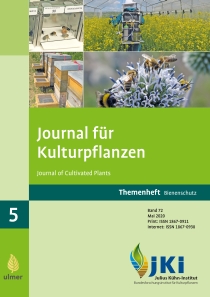Effects of tank mixtures of plant protection products on honey bees and possible physiological interactions
DOI:
https://doi.org/10.5073/JfK.2020.05.05Keywords:
Honey bees, Tank mixtures, Synergistic impacts, DetoxificationAbstract
During foraging bouts pollinators like honey bees may be exposed to multiple plant protection products (PPPs). In contrast to applications of single PPPs the effects of tank mixtures are not routinely evaluated in the risk assessment process of PPPs with the exception of known synergistic insecticides and mixing partners. Due to economical constraints and process efficiency PPP mixtures are commonly used in agricultural practices. However, sometimes interactions among agrochemicals lead to undesirable additive and synergistic effects. Especially mixtures of pyrethroids or neonicotinoids with azole fungicides, which inhibit sterol biosynthesis, have a synergistic potential of negatively affecting honey bees. For such mixtures, regulatory restrictions are already in place. These synergistic effects are associated with azole fungicides inhibiting the main detoxification enzyme P450, which hinders the bee to detoxify the insecticide. Further studies provide first evidence for increased impacts of mixtures of insecticides with adjuvants on honey bees. More research is necessary to better understand mixture toxicity and to implement this knowledge in the risk assessment.
Downloads
Published
Issue
Section
License
The content of the journal is licensed under the Creative Commons Attribution 4.0 License. Any user is free to share and adapt (remix, transform, build upon) the content as long as the original publication is attributed (authors, title, year, journal, issue, pages).
The copyright of the published work remains with the authors. The authors grant the Journal of Cultivated Plants, the Julius Kühn-Institut and the OpenAgrar repository the non-exclusive right to distribute and exploit the work.







